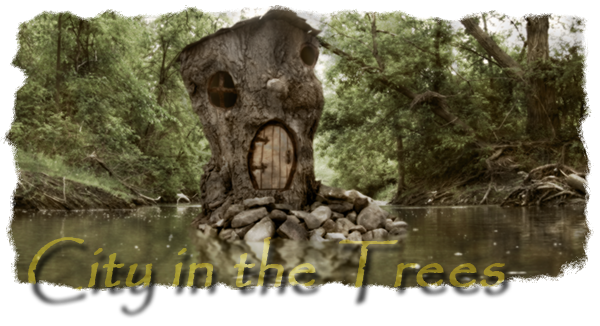About a month ago, looking at images in that imminently-useful tool, GoogleMaps, I happen to notice a second bridge on Dundas Street in Oakville that was accompanied by what was clearly a set of supports for an older, removed bridge. This was on Sixteen Mile Creek; earlier this summer I undertook visiting the set on Twelve Mile Creek and shots from that trek appear in this blog. The set at Sixteen Mile Creek consisted of, from what I could see, six tall slabs (judging from their shadows) and the concrete abutments at either end. I was, in my geeky way, delighted. It seemed there was a park at the base of the bridge (Lions Valley Park), fed by a road in from Dundas Street, and so I decided to head over there and take a look.

I went the first weekend in September... on Labour Day, if I'm not mistaken. I was surprised when I got there to find the road down to the park was closed by construction. I ended up parking in the nearby subdivision (one of those ritzy, unfriendly ones that largely bans parking on its streets and is mostly free of those encouragements to foreign interlopers called "sidewalks") and made my way to the blocked road and down into the valley.
Even on the way down, I could see something was up. Dead ahead through the screen of trees and at the bottom of the road, I could see a concrete and steel construction, filling the view. This turned out to be a new bridge support. And of the six ancient ones I had come in hopes of seeing, only two remained. Of the other four, no hint remained. I was really disappointed... I had hoped to get a few dramatic shots of the six dethroned bridge supports standing like gigantic dominos in a row. No such luck. But I was intrigued by all the new construction. A footbridge to the north of the current Dundas Street bridge was also gone; in its place, two new bridges on the south side... one clearly meant for pedestrian traffic and likely permanent; the other a bridge for construction vehicles that will probably be removed when the work is through in a couple of years.





I made my way to the west side of the creek and then up into the park. Eventually, I drifted to creek itself and waded up its course for about a quarter of a mile, and then beyond its first bend I hiked up into the forest for a while. I followed the reverse course on my return.


In the days following my trip there, I went online and tried to determine just exactly what the plan was for all the construction there. I discovered that the course of the old, long-removed bridge was about to be recovered by a three-lane eastbound bridge. I also discovered that the current four-lane Dundas Street bridge is due to be torn down, and replaced by a twin span carrying three lanes westbound. So the existing single four-lane span will be replaced by two three-lane spans over the next couple of years or so. Once the first bridge is built, I expect the existing span will begin to be torn down... and I would like to record that process. One day, a generation from now, someone like me will wonder what that bridge looked like, how it appeared in the valley (just as I do about the long-gone bridge those six dominoes once hefted across the valley). I'm hoping this entry, and some of these shots, will survive somehow to show that.
My research also uncovered a really interesting fact: down in the valley there, there had once been a small village, with something like 500 people living there at its peak in the 1850s. It was called Proudfoot's Hollow after the man who owned the mill, and it served the port of Oakville at the time. The coming of the railroad effectively killed the village, since it effectively killed that same port. By 1880, it was pretty much abandoned. It must have been something to see. Apparently there's a painting of it at the Halton Regional Archives in Milton... I intend to go see it soon.

Another interesting thing about the place, to me personally, is that it was once a migratory station for the passenger pigeon. At the time of height of the village's population, when millions of these birds would visit the place, their droppings were apparently copious enough to kill trees. Who then would have imagined that within the span of a single human lifetime, the last passenger pigeon would die, in captivity, in 1914? Would they have believed that a child who had seen the former could live to bear witness to the latter? Modern extinctions have always fascinated me, but none more so than the passenger pigeon. To reflect that where I walked, waded, hiked, had once been full of millions of these birds that probably only a bare handful of people still alive today could ever have seen — and even then, only in two or three zoos — that realization amazes me. No one living today ever saw one in the wild; the last was shot in 1900. Within a decade, we will be able to say, with full confidence, that no living person ever saw a living, breathing passenger pigeon... once the most numerous single species of bird in all the world.
I returned to the place on the last weekend of September, wondering if I would find the last two remaining supports from the 1920s bridge pulled down. They still remained. I began to wonder if they plan was to retain them for some purpose. Time will tell.
I noticed two particular differences from the last time I was there. The first was a new support beginning construction. The second was that the abutment on the west side was plainly, and quite broadly visible. It dwarfed the abutment for the 1920s bridge that juts from the valley wall just below it.
I find all this truly interesting. Everywhere you look, evidence of bridges... past, present, and future. With a casual glance, in a single image, it is easy — in fact, nearly inevitable — to glimpse all three at once. Perhaps most poignant of all to me is the knowledge that the tall, impressive span existing there today and carrying all the traffic of Dundas Street across the valley from height to height is itself doomed. By the end of the decade, probably, it will be a memory. I hope my pictures will help people, especially people in the future, to remember it. They are, at least, in colour... sorry, 3D isn't a genuinely viable option just yet. :)


No comments:
Post a Comment